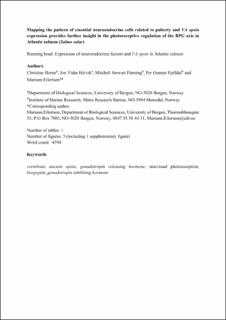Mapping the pattern of essential neuroendocrine cells related to puberty and VA opsin expression provides further insight in the photoreceptive regulation of the BPG axis in Atlantic salmon (Salmo salar)
Horne, Christine; Helvik, Jon Vidar; Fleming, Mitchell Stewart; Fjelldal, Per Gunnar; Eilertsen, Mariann
Peer reviewed, Journal article
Accepted version
Permanent lenke
https://hdl.handle.net/11250/3057048Utgivelsesdato
2022Metadata
Vis full innførselSamlinger
- Articles [3012]
- Publikasjoner fra CRIStin [3070]
Originalversjon
10.1159/000526188Sammendrag
In Atlantic salmon (Salmo salar), seasonal photoperiod is shown to regulate the onset of sexual maturation, yet which brain region(s) is involved, and how light information impacts the neuroendocrine system are still not fully understood in teleosts. Detailed knowledge about the photoperiodic regulation of maturation in fish is still missing. In birds, it is shown that gonadotropin-releasing hormone (Gnrh) is located in the same neurons as vertebrate ancient (VA) opsin, suggesting a direct photoreceptive regulation for the onset of sexual maturity. This study presents a comprehensive topographic mapping of gnrh2, gnrh3, kisspeptin 2 (kiss2), gonadotropin-inhibiting hormone (gnih), and VA opsin using in situ hybridization on mature Atlantic salmon brains. Neurons positive for gnrh3 are expressed in the olfactory bulb and ventral telencephalon, while gnrh2-positive neurons are located dorsally in the midbrain tegmentum. Gonadotropin-inhibiting hormone (Gnih)-expressing cell bodies are present in the ventral thalamus and extend caudally to the hypothalamus with kiss2-expressing cells appearing in a lateral position. VA opsin-positive cells are present in the telencephalon, the rostro-dorsal ring of the left habenula, the ventral thalamus, and the midbrain tegmentum. The results show no similar co-location as found in birds, hypothesizing that the photoreceptive modulation of Gnrh in salmon may interact through neuronal networks. The topography analyses of the essential neuroendocrine cells related to sexual maturation in the Atlantic salmon brain show that diencephalic (thalamus, hypothalamus) and midbrain (tegmentum) regions seem central for controlling sexual maturation.
